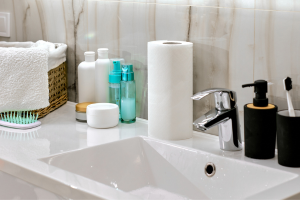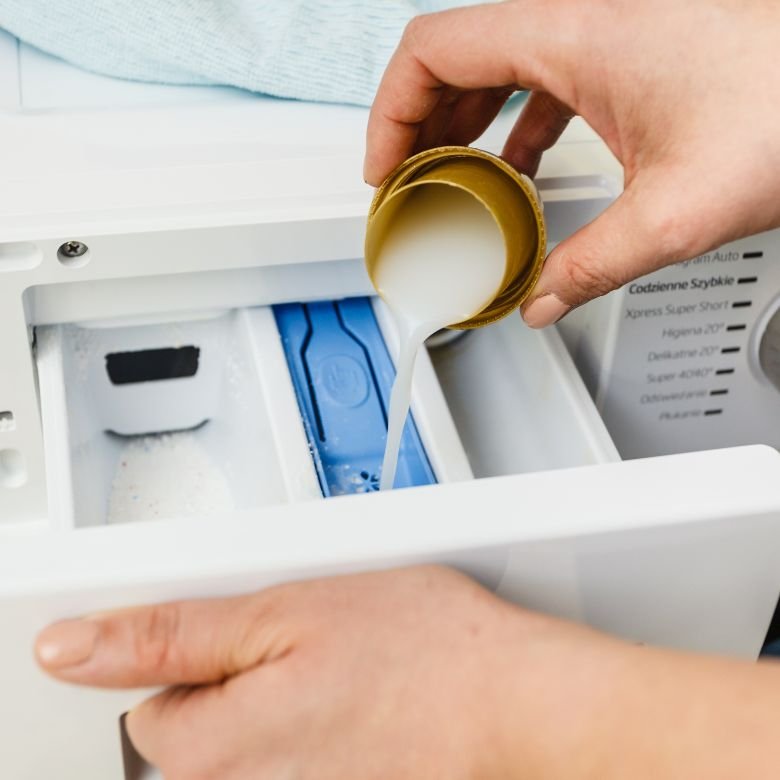In consequence of the advancement of science and technology, today we are surrounded by millions of special-purpose chemical products. When referring to chemicals, we often only mean the very much needed everyday cleaning products. Yet, there is more to chemicals than this category. In addition to all kinds of laundry and cleaning detergents, everyone also keeps cosmetics, toothpaste and mouthwash, a mini first aid kit or disinfectants in their bathroom. Plus, there are such staples as water: it, too, is a chemical compound!

Water, that is…
…nothing more than a chemical compound, also known as hydrogen oxide, with the chemical formula H2O. It can come in three states of concentration: liquid, solid and gas. In addition to its direct application, water is also commonly used as an ingredient and solvent for numerous chemicals and cosmetics. It has excellent solvent properties, especially towards polar substances due to their similarity.
Laundry agents
It is a category of household chemicals most associated with the bathroom, with various substances forming a very specific mixture. Acting together and combined with adequate conditions, in other words, with mechanical movement of the washing machine and the friction of manual movement at the right temperature and in the right environment, enable the products for which they are intended to be kept clean. The most important factor critical to the effectiveness of such an agent is its chemical composition. The substances used and their relevant proportions determine the characteristics of the product. Surfactants, otherwise known as surface-active agents, play a key role in product formulation. They can have varied structures and are classified into three main categories: anionic, cationic and non-ionic surfactants. They have different mechanisms of action, but largely have the same goal, namely to reduce the surface tension between phases, for example, water and the soiled fabric. They enable the washed fabric to be wetted faster and reach the dirt more efficiently, which usually is hydrophobic and does not dissolve in water. The use of surfactants allows dirt to be broken off of the fabric, gradually break it down into the smallest possible particles and suspend the laundry agent in solution.
Soap
Soap is a commonly used surfactant. In chemical terms, it is a sodium or potassium salt of higher fatty acids, for example, stearic, palmitic and oleic acid. Potassium soaps are mainly used for laundry, and are grey and slimy. Sodium soaps, on the other hand, are hard and white, and often use added oils, coconut or argan oils, fragrance oils, sulphur, chamomile and dyes, so they can be used as toilet soaps and sometimes medicinal soaps. Each soap molecule has two parts of opposing properties: hydrophilic and hydrophobic, which is a characteristic feature of surfactants. This enables to reduce surface tension and improve the penetration of water molecules into soiled surfaces. The dirt particle is surrounded by the hydrophobic part of the soap, and then it gets detached from the surface. The foaming property of these agents, activated through intense agitation, ensures that dirt particles do not adhere once again to an already cleaned surface, because, surrounded by the hydrophilic part of the soap, they are lifted upward by the foam.
Read more about soap production.
Active fillers
These include all ingredients besides surfactants that play a role in the composition of cleaning products. Their presence improves the action of surfactants, which can be called a kind of synergism. Their main aim is to soften hard water by removing calcium and magnesium ions from it. This is important because of the strongly adverse effects of these ions on washing processes. Sodium bicarbonate, alkali silicates, citrates and phosphates are most commonly used in this role. Even though the most commonly used active filler is tripolyphosphate, for environmental reasons it is more and more often replaced by a mixture consisting of zeolite-A, sodium carbonate and polycarboxylates.
Special additives
Obviously, a given composition is not always universal. There are chemical compounds that make a chemical agent have a specialised effect. One example is the use of PVP polymer, which inhibits the transfer of dyes between fabrics. This makes it perfect as an ingredient in washing powders and liquids designed for colour fabrics. Another interesting example is cellulose, which destroys microfibres. They are formed during the so-called piling, that is disruption of the fabric’s fibre structure. A separate group of additives that do not directly influence the performance of the product are foam inhibitors and all kinds of fragrance compositions.
Enzymes
Another group of substances found in laundry detergents are enzymes, the addition of which not only aids in the removal of stains, but also in bleaching or enhancing fabric colour. Enzymes are very selective, so every type of enzyme can clean a different type of dirt. For example:
- proteases induce biochemical breakup of protein contaminations;
- mannanases allow the removal of stains from chocolate, sauces or ice cream;
- lipases remove fatty soils;
- amylases allow starch-based stains to be removed;
- proteases assist in the process of removal of grass, blood and egg stains.

Chemical bleaches
Chemical bleaches are substances used for special purposes such as removal of coffee, wine or tomato stains. These are compounds that, at high temperatures, release atomic oxygen capable of gradual breakup of the colours present in stains. In addition to the bleaching compounds, such products also contain activators, which accelerate the action of the bleach at lower temperatures. In addition to stain removal, such active oxygen has another very important function for the hygiene of personal products. It allows the elimination of bacteria, viruses and fungi, resulting in clean and sterile clothing.
Cleaning liquids and disinfectants for sanitation hygiene
These are products commonly used for household toilets for their disinfectant, cleaning and whitening effect. When you look at the label, your will often come across such generalities as chlorine-based bleaching compounds, non-ionic surfactants, cationic surfactants, soap, and fragrance composition. The most important information for your health is that agents based on chlorine, most often in the form of chlorates, can potentially be dangerous. These perishable salts oxidise during bleaching and break down into active oxygen and smaller amounts of chlorine. Chlorine is easily noticeable because of its characteristic odour that is irritating to the respiratory tract. Inhaling it in large quantities can lead to severe poisoning, so you should use it responsibly, only under controlled conditions with free access to fresh air. The worst combination is chlorine bleach and acidic liquids, such as lemon juice or vinegar. Chlorates are stable only in alkaline environments, so putting them into acidic solutions results in rapid release of large amounts of chlorine and chlorine oxide, which are highly toxic.
See the range of disinfectants from the PCC Group.
Oral hygiene
A separate category of bathroom chemicals includes all kinds of toothpastes and oral hygiene formulas. Toothpastes include:
- abrasive substances (25–50%), which are supposed to mechanically clean the surface of the teeth, namely calcium carbonate, calcium and magnesium hydroxides, silicon oxide, hydroxyapatite and polymethacrylate;
- foaming substances that reduce surface tension to help remove plaque. In this role, SLS or anionic sodium laurosulfate, is used most often;
- fluoride, a key ingredient of toothpaste, is usually found in the form of sodium fluoride, sodium monofluorophosphate, tin fluoride or amine fluoride. It increases resistance to acids, which are produced by carious bacteria, by penetrating into the structure of tooth enamel;
- triclosan, an antibacterial and anti-inflammatory ingredient;
- herbs and fragrances responsible not only for mild anti-inflammatory, antibacterial and antifungal effects, but also for the feeling of freshness and improving taste.

Cosmetic chemistry
Every bathroom also comes with cosmetics such as shampoos, conditioners, cleansers, moisturisers and much more. The safety of their composition is monitored by a number of independent institutions: the European Commission, the Scientific Committee on Consumer Safety, the European Chemicals Agency, EU member states and the State Sanitary Inspectorate. The key elements of every formulation are:
- Active substances, i.e., the ingredients that can actually influence specific skin conditions. This most often refers to the division of skin types into oily, dry, sensitive and mature skin. Examples of such substances include vitamins A, C and E, probiotics, AHA acid, hyaluronic acid and Q10 coenzyme. Here, their presence an important aspect, but the concentration of it is important, too.
- Base substances that constitute the basis for the formulation in question, for example, a cream or gel. These include alcohols, water, emulsifiers, surfactants and silicones, among others. In addition to imparting the right texture, they also help to introduce active ingredients more easily by using solvents.
- Solvents, on the other hand, are substances that are designed to dissolve all the components of a given formulation. The most commonly used solvents are water, oils and alcohols, depending on which one best dissolves the desired active ingredient.
- Like in most chemicals, surfactants have a number of uses, which include cleaning, foaming, thickening, emulsifying and aiding the penetration of cosmetics into the skin.
- Preservatives are agents designed to inhibit the growth of microorganisms carried on our skin and by air, so the cosmetic can remain on the skin for a longer period of time. In addition to synthetic chemicals, there are also many natural ones, such as essential oils (cloves, tea tree) and plant extracts (grapefruit, rosemary) that are also perfect as preservatives.
Read more about the production of cosmetics and cosmetic intermediates. Also find out how to produce cosmetics at home using the right cosmetic raw materials.
Your medicine cabinet
Although few people think about it, most of the contents of our medicine cabinets are also chemicals. Pharmaceuticals must meet a number of requirements and pass a series of quality control tests before they are released to the market. Your first aid cabinet may include, among other things: disinfectants such as 3% hydrogen peroxide and rubbing alcohol (surgical spirit) as well as a range of medicines for various ailments. Common medications kept at home include:
- analgesics and anti-inflammatories – usually based on paracetamol, ibuprofen and acetylsalicylic acid;
- anti-diarrhoea medicines – containing such agents as activated charcoal, albumin tannate, loperamide or nifuroxazide;
- electrolytes – particularly useful during diarrhoea to prevent dehydration; they are usually aqueous solutions of sodium, potassium, calcium, magnesium, chlorine and phosphorus ions;
- saline – an aqueous solution of sodium chloride;
- various forms of calcium, which relieves allergic reactions.
Every home also has many medicines for specific ailments of the household members. Each of them is a chemical product with a well-defined composition.